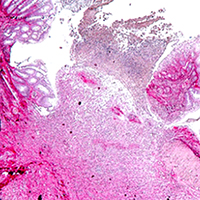Anastomotic healing in a rat model of peritonitis after non-steroidal anti-inflammatory drug administration

Submitted: 12 November 2019
Accepted: 27 December 2019
Published: 10 January 2020
Accepted: 27 December 2019
Abstract Views: 1113
PDF: 670
HTML: 12
HTML: 12
Publisher's note
All claims expressed in this article are solely those of the authors and do not necessarily represent those of their affiliated organizations, or those of the publisher, the editors and the reviewers. Any product that may be evaluated in this article or claim that may be made by its manufacturer is not guaranteed or endorsed by the publisher.
All claims expressed in this article are solely those of the authors and do not necessarily represent those of their affiliated organizations, or those of the publisher, the editors and the reviewers. Any product that may be evaluated in this article or claim that may be made by its manufacturer is not guaranteed or endorsed by the publisher.
Similar Articles
- Roberta Sferra, Simona Pompili, Luca Ventura, Caroline Dubuquoy, Silvia Speca, Eugenio Gaudio, Giovanni Latella, Antonella Vetuschi, Interaction between sphingosine kinase/sphingosine 1 phosphate and transforming growth factor-β/Smads pathways in experimental intestinal fibrosis. An in vivo immunohistochemical study , European Journal of Histochemistry: Vol. 62 No. 3 (2018)
- Wanchun Wang, Jun Yi, Degang Dong, Wenli Mao, Xuanyu Wang, Zhangren Yan, miRNA-877-5p inhibits malignant progression of prostate cancer by directly targeting SSFA2 , European Journal of Histochemistry: Vol. 65 No. 3 (2021)
- A. Sbarbati, D. Accorsi, D. Benati, L. Marchetti, G. Orsini, G. Rigotti, P. Panettiere, Subcutaneous adipose tissue classification , European Journal of Histochemistry: Vol. 54 No. 4 (2010)
- A. Bolekova, T. Spakovska, D. Kluchova, S. Toth, J. Vesela, NADPH-diaphorase expression in the rat jejunum after intestinal ischemia/reperfusion , European Journal of Histochemistry: Vol. 55 No. 3 (2011)
- Zhijiang Chen, Huili Wang, Bin Hu, Xinxin Chen, Meiyu Zheng, Lili Liang, Juanjuan Lyu, Qiyi Zeng, Erratum - Transcription factor nuclear factor erythroid 2 p45-related factor 2 (NRF2) ameliorates sepsis-associated acute kidney injury by maintaining mitochondrial homeostasis and improving the mitochondrial function , European Journal of Histochemistry: Vol. 67 No. 2 (2023)
- I Kasacka, AM Humenczyk-Zybala, M Niczyporuk, G Mycko, Morphometric evaluation of murine pulmonary mast cells in experimental hemorrhagic shock , European Journal of Histochemistry: Vol. 48 No. 2 (2004)
- T. Nara, T. Yasui, O. Fujimori, W. Meyer, A. Tsukise, Histochemical properties of sialic acids and antimicrobial substances in canine anal glands , European Journal of Histochemistry: Vol. 55 No. 3 (2011)
- J.M. Ou, Z.Y. Yu, M.K. Qiu, Y.X. Dai, Q. Dong, J. Shen, X.F. Wang, Y.B. Liu, Z.W. Quan, Z.W. Fei, Knockdown of VEGFR2 inhibits proliferation and induces apoptosis in hemangioma-derived endothelial cells , European Journal of Histochemistry: Vol. 58 No. 1 (2014)
- Giuliano Mazzini, The Feulgen reaction: from pink-magenta to rainbow fluorescent at the Maffo Vialli’s School of Histochemistry , European Journal of Histochemistry: Vol. 68 No. 1 (2024): 1954-2024: 70 Years of Histochemical Research
- M. Lehmann, F. Martin, K. Mannigel, K. Kaltschmidt, U. Sack, U. Anderer, Three-dimensional scaffold-free fusion culture: the way to enhance chondrogenesis of in vitro propagated human articular chondrocytes , European Journal of Histochemistry: Vol. 57 No. 4 (2013)
<< < 18 19 20 21 22 23 24 25 26 27 > >>
You may also start an advanced similarity search for this article.

 https://doi.org/10.4081/ejh.2020.3085
https://doi.org/10.4081/ejh.2020.3085










